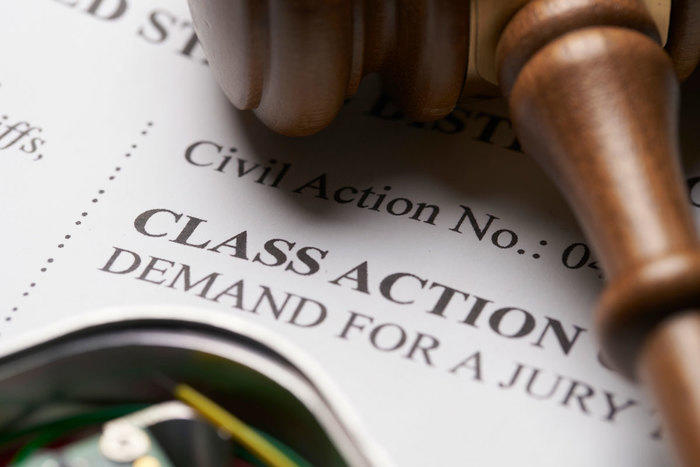Assertio Class Action Lawsuit: Insights into Class Action Lawsuits
Assertio Class Action Lawsuit: Insights into Class Action Lawsuits
Blog Article
Discovering Class Activity Legal Actions: What You Required to Know
Course activity lawsuits have actually become significantly common in today's legal landscape, with people signing up with forces to seek remedy versus organizations and firms. In this discussion, we will certainly explore the ins and outs of course action claims, shedding light on their interpretation, the requirements for declaring, and the potential advantages and disadvantages included.
The Definition of Class Activity Suits
A class action claim is a lawful activity filed by a group of people who have comparable cases versus an offender. Course action claims are commonly brought when the number of possible complainants is also big for private suits to be practical.
One of the crucial elements of a course activity suit is that the lead plaintiff, additionally called the class rep, stands for the passions of all the class members. The court designates the lead plaintiff based on their ability to fairly and sufficiently represent the class. The lead plaintiff works closely with the course action attorney to construct a solid case and seek settlement or other remedies on part of the whole class.
In order for a course action lawsuit to continue, the court should certify the class. This implies that the court determines that the legal action satisfies certain demands, such as numerosity (a large enough variety of class participants), commonality (usual concerns of law or truth), typicality (the insurance claims of the lead plaintiff are normal of the class), and competence of representation (the lead plaintiff and course advice are capable of standing for the class's passions) Once the course is certified, the suit can move on, and any judgment or negotiation reached will relate to all class participants unless they choose to opt-out.
Course activity suits offer a necessary purpose in giving accessibility to justice for individuals that might not have the resources to pursue their claims separately. They also advertise effectiveness in the lawful system by consolidating similar cases into a single activity, reducing the concern on both the court and the events included.
Needs for Filing a Class Action Claim

One more need is that the class must be sufficiently various. The exact number of class members called for may differ depending on the territory and the nature of the instance. It is usually anticipated that the class has to be big enough that joining all the private complainants right into a solitary claim is extra effective than having numerous different suits.
In addition, it is necessary that the class agent, that is the private or entity bringing the claim in support of the course, has normal claims and defenses to those of the class members. The representative must additionally be able to effectively and fairly stand for the interests of the whole class.

Advantages and Downsides of Course Action Legal Actions
Course action suits use both advantages and drawbacks for complainants and accuseds associated with the legal process. On the one hand, one of the considerable advantages of class activity suits is that they provide a cost-efficient and reliable way for people with similar cases to go after justice collectively. By combining numerous comparable cases right into one claim, class activities enhance the legal procedure and save time and sources for both accuseds and complainants.
One more advantage of class action legal actions is that they allow people with minimal resources to seek compensation for their problems. In cases where the prospective recuperation is small, private claims might not be economically practical. By joining forces in a course action, plaintiffs can pool their resources and boost their opportunities of obtaining a fair resolution.
Furthermore, class activities can advertise social adjustment by holding firms accountable for their actions. By bringing interest to extensive transgression or faulty products, course activities can pressure companies to change their practices, improve item security, or carry out reforms.
Nonetheless, course activities likewise have downsides. One prospective downside is that specific complainants may have limited control over the litigation process and the ultimate end result of the instance. The lead plaintiffs and their lawyers normally make crucial choices in support of the entire class, which may not constantly straighten with the specific rate of interests of each class member.
Additionally, class actions can be time-consuming and extensive, typically taking years to reach a resolution. The complexity and dimension of these legal actions can bring about hold-ups and extended litigation, which can be discouraging for both offenders and complainants seeking a prompt resolution.
Actions Involved in a Course Activity Legal Action
The procedure of a class activity suit generally starts with the identification of a prospective class and the declaring of a grievance. As soon as a group of people who share comparable insurance claims versus a defendant is recognized, the lead plaintiff, or course representative, submits a grievance in support of the entire class. This issue describes the claimed wrongdoing and looks for damages or other alleviation for all members of the class.
After the complaint is submitted, the court will certainly figure out whether the case satisfies the requirements for class certification. These demands generally consist of numerosity (a huge enough course), commonness (comparable lawful insurance claims), typicality (the lead complainant's claims are representative of the course), and competence of representation (the lead plaintiff and their attorney can appropriately represent the class's interests)
If the court licenses the class, notification is provided to all possible class members, offering them the chance to opt-out if they desire to seek their own specific claims - Assertio class action lawsuit. If a sufficient number of class members stay, the instance will certainly proceed to the exploration stage, where both sides collect proof and details pertinent to the cases
Following exploration, the events might take part in negotiation arrangements or continue to test. If the instance mosts likely to trial and the class prevails, the court will certainly establish the appropriate damages or alleviation to be awarded to the class members.
Recent Site Class Action Suits
With a solid understanding of the actions entailed in a class activity legal action, it is currently crucial to check out some current spots cases that have actually made a significant impact in the lawful landscape. Assertio class action lawsuit. These instances have not just shaped the means course action suits are conducted but have actually likewise produced changes in numerous sectors
One such landmark instance is the Volkswagen emissions rumor, which led to the largest course action negotiation in vehicle history. This deceptiveness affected millions of customers worldwide, leading to a class activity lawsuit.
One more notable situation is the Johnson & Johnson talc claim. Thousands of ladies submitted suits versus the company, declaring that their talcum powder items caused ovarian cancer. In 2018, a court granted $4.7 billion in damages to 22 complainants. This instance raised concerns concerning the safety of talcum powder and triggered Johnson & Johnson to change their product labeling.
These current spots cases demonstrate the power of class activity legal actions in holding corporations responsible for their actions and looking for justice for damaged people. They work as examples of how course activity claims can cause substantial changes and safeguard the civil liberties of consumers.
Final Thought
Finally, class activity suits are a Assertio class action lawsuit lawful device that enables a group of people to jointly look for justice for a common grievance. While they offer numerous advantages such as efficiency and cost-effectiveness, there are also drawbacks such as prospective for limited compensation and lengthy legal proceedings. Comprehending the demands and steps associated with filing a class action lawsuit is important for individuals seeking to pursue this lawful method. Recent landmark class activity legal actions have actually highlighted the relevance of such situations in advocating for consumer civil liberties and corporate liability.
One of the vital aspects of a class activity suit is that the lead complainant, additionally understood as the course agent, represents the passions of all the class participants.In order for a class activity claim to proceed, the court has to accredit the class. This indicates that the court identifies that the legal action satisfies particular demands, such as numerosity (a big enough number of course members), commonality (usual questions of regulation or fact), typicality (the cases of the lead plaintiff are typical of the course), and competence of representation (the lead complainant and class guidance are qualified of representing the course's interests) Once the class is accredited, the legal action can move onward, and any kind of judgment or negotiation got to will apply to all course members unless they choose to opt-out.
The procedure of a course action lawsuit commonly begins with the identification of a possible course and the filing of a problem.
Report this page